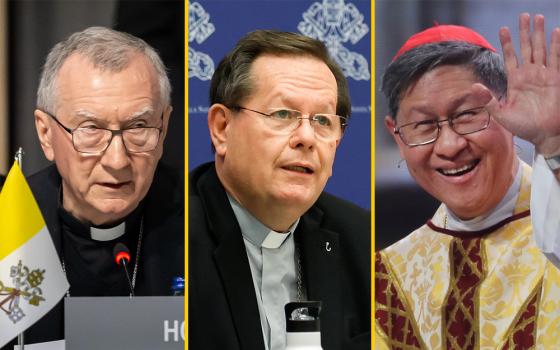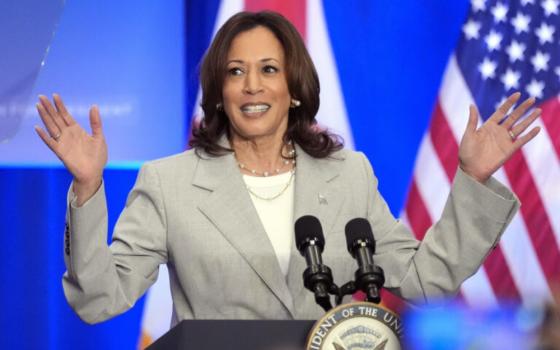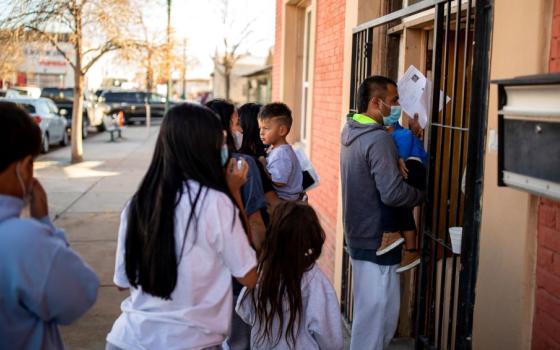Having prayed our way through Holy Week, we are only too aware that the disciples, particularly the men among them, performed poorly during the events of Jesus’ passion. Unsurprisingly, they didn’t do a lot better with the Resurrection. The Gospel for the Easter Vigil (Luke 24:1-12) tells us that women were the only ones to visit Jesus’ tomb. They found it empty and believed the angel who reminded them that Jesus had foretold this. The eleven leading men with whom the women shared their news assumed it was all nonsense. Only Peter took them seriously enough to go see for himself, and he returned amazed, but still as confused as ever about the women’s testimony.
The Easter Sunday morning Gospel (John 20:1-9) reveals that of all of them, only Mary Magdalen spoke the truth about the disciples’ immediate situation. That happened rather inadvertently when she admitted that “they” had taken the Lord and “we” do not know where he is. The disciples were in a state of confusion — at best.
The Gospel for Easter Sunday afternoon (Luke 24:13-36) returns to Luke’s narrative and Jesus’ surprise encounter with two disciples leaving Jerusalem for the town of Emmaus. They were on a journey of seven miles; geographically and symbolically, they expected it to be all downhill.
Luke doesn’t explain their motive for travel, but it’s a good guess that they were fleeing the scene of death and the threat of danger. Traditional images of the pair depict them as two men, but Luke never specifies. The fact that only Cleopas is named leads some to suggest that his companion was a woman, perhaps his wife who seems to have been one of the four women whom John says kept vigil by Jesus’ cross. Luke’s interest is not in identifying them, but in letting us know how they came to recognize the risen Lord.
This pair, whether traveling alone or as part of a large group of pilgrims returning home after the holy days, were deep in conversation and debate with one another. Then Jesus, who generally avoided getting involved in others’ arguments, interrupted them and asked why they were so agitated.
They stopped long enough for him to appreciate how their faces reflected their broken hearts. Then Cleopas, thinking that Jesus must have been the most unobservant of Jews in Jerusalem, asked how anyone could be unaware of the things they were discussing. Jesus listened as Cleopas explained how Jesus the prophet had been handed over by the religious leaders and crucified. Cleopas explained that they had gambled all their hope on Jesus and it had come to worse than naught. He added that some women had gone to the tomb, found it empty, and thought they saw angels. Cleopas added the information that some levelheaded men then went and found the tomb just as empty as the women had said. Then, summarizing everything, he finished, saying: “Him they did not see.”
When Jesus could get a word in edgewise, he snapped them to attention by calling them foolish and slow to believe. Through all the time he had been with them — whether over the years or the course of the few miles they had walked together — they hadn’t recognized who he was.
Perhaps their hearts had to be broken before they were capable of letting go of the narrow religious ideals they had cherished. Their image of an omnipotent, ever-victorious God had left no room for Jesus’ unique revelation of divine self-giving and suffering love.
Luke constructs this story as a liturgy. The disciples’ brokenhearted conversation and Jesus’ description of them as foolish and sluggish of heart called them to believe in something bigger than their closed ideas and limited hopes. That served as a penitential rite, calling them to believe in God rather than cling to their perceptions.
The Liturgy of the Word, as it were, was Jesus’ refocusing of their understanding of their Scriptures and tradition. Like the crowds who marveled that Jesus spoke with authority, the two disciples found that their hearts were burning as he explained the Scriptures from the vantage point of God’s great love.
Sharing the word left them hungering for more. They begged him to remain with them. He did so by bringing them back to the table of self-giving love. Breaking the bread with them, he taught them how to remain in his presence by doing what he did. With that, they recognized who he was and had always been. Though he disappeared, they were ready to spread the news that he would find them anytime they opened their hearts to a larger perception of God’s ways and every time they joined in the communion of his self-giving love.
ACTS 10:34a, 37-43
This short reading begins with Peter making a solemn speech; this one will be his last in the Acts of the Apostles. Peter begins with a succinct catechesis, an explanation of the events of the life, death and resurrection of Jesus of Nazareth. He is preaching to a pagan named Cornelius and his household, the family God chose to open the minds of the disciples to the Christian vocation of the Gentiles. In this snippet, we only get Peter’s historical creed. The Roman Lectionary skips the story of how the Spirit worked to bring Peter and Cornelius together and Peter’s miraculous conversion to a broader understanding of how God works among all of humankind.
Parts of Peter’s instruction come off as objective and factual. He said that God’s new project in Jesus began after John the Baptist’s preaching. He explains that Jesus’ ministry flowed from the Holy Spirit. Rather than give a long resume, Peter sums up Jesus’ life simply saying, “He went about doing good.” Then, without assigning either motive or blame, with no more drama than he used in saying that Jesus healed the oppressed, Peter went on to say that “they” put him to death by hanging him on a tree.
What Peter takes pains to talk about in detail is the fact that God raised Jesus on the third day. He adds that God willed that Jesus be visible to chosen witnesses. These people ate and drank with him as his companions had done before his death.
After this, Peter begins to theologize and explain his own mission. He says that the risen Christ commissioned the group of witnesses to testify to him. He then explains who Jesus is in relation to the Jewish tradition. He subtly hints at Jesus’ timelessness by explaining that he was the one awaited by the prophets and is the judge who is to come. With this, Peter had apparently said enough; the Holy Spirit abruptly interrupted his discourse and came upon Cornelius and his household, filling them with grace.
Luke used Peter’s speech to summarize his Gospel. The story Peter told began in an obscure place in Galilee and ended in Jerusalem, the capital city of God’s chosen people. From there, the story will progress to Cornelius and his like all the way to Rome. This is Luke’s explanation that the work Jesus initiated is destined to reach the whole world. With this incident, Peter has completed his rounds of imitating Jesus’ ministry. Like Jesus, he had healed a paralyzed man, he raised Tabitha to life as Jesus had raised Jairus’ daughter, and in this incident, he recognized Cornelius’ faith in the same way that Jesus had marveled at the faith of a centurion.
As the first reading for Easter Sunday, this offers us a variety of avenues for meditation. On one hand, Peter’s simple creed outlines what is essential to our faith. Without a single word of philosophical language, Peter tells us that God anointed Jesus to do good. When the powers of evil tried to overcome him, the love and life-giving power of God overcame them. That was all he needed to know and to preach.
On another level, we realize that, by reproducing the life of Jesus in his own ministry, Peter is showing us the pattern of the Christian vocation. We also see that Peter has learned to interpret all that happens in the light of Jesus’ revelation of God’s love. Finally, at the end of his story, Peter appears to us as a model we can follow in ministry and not just an example of a loveable, outspoken bungler whose primary witness showed the world how to ask pardon. Peter’s ministry shows us how much God can accomplish with any of us.
COLOSSIANS 3:1-4
This section of the Letter to the Colossians could sound hopelessly esoteric if we take it at face value without understanding Paul’s imagination. For Paul, everything about the community’s life is now based on the fact that they have been raised with Christ. Their life is not what it used to be, nor is it like that of people around them who do not understand their faith. This vision of Christian life cannot develop all at once simply because a person has passed through the baptismal waters. This way of life has to be cultivated.
When Paul encourages the community to seek what is above, he isn’t sending the community on a vision quest. Instead, he is reminding them that Jesus of Nazareth, the man for others, was executed for his faithfulness, and is now exalted in the very presence of God. Paul uses that idea to explain that Jesus’ exaltation and victory are more solid than anything they see around them. If they wish to share his life, then they need to look to him as their model, eschewing what their world promotes as success and status.
When Paul reminds the community that they have died, he is speaking with the utmost seriousness and sincerity. This was no simple figure of speech. Their baptism was a renunciation of the values of the world, a passing through death to the new life they are beginning and will eventually experience in its fullness. Their baptism is a grace that demands their total commitment. It also engenders hope because they believe that what they see now is nothing compared to what they will know “when Christ, your life appears.”
1 CORINTHIANS 5:6b-8
This short selection from Paul’s First Letter to the Corinthians picks up in the middle of Paul’s reproach of the community for ignoring a case of grave sexual immorality among them. In Paul’s understanding, everything in the life of an individual has repercussions for the entire community. They are so bound together that a case of serious sin is like a cancer, it cannot be allowed to grow untreated; every activity of every member is like leaven that affects all the dough.
The particular problem Paul is dealing with is a case of incest, but the broader issue is the well-being and integrity of the Christian community. Christians are people who celebrate freedom and forgiveness, but they can’t take that as license and pretend that there is no such thing as morality. Just the opposite. Because this group forms the body of Christ, because they are the bread of a new Passover, they must continually strive to become all that they are called and enabled to be. To accept anything less is to denigrate the body of Christ, and that, like unworthy participation in the Eucharist, is tantamount to participating in the Crucifixion. (See 1 Corinthians 11:27.)
LUKE 24:13-36
The story of the Emmaus encounter (the option for the afternoon Gospel reading) gets its name from the disciples’ destination and the path of gradual resolution of their desperate dejection. We can meditate on it as the core Christian pilgrimage, the journey on which we must face the facts of evil, failure and disillusionment, the journey through fear and shattered hopes to missionary faith. Pope Francis urges us to embark on this journey saying:
I do exhort all the communities to an “ever watchful scrutiny of the signs of the times.” This is in fact a grave responsibility, since certain present realities, unless effectively dealt with, are capable of setting off processes of dehumanization which would then be hard to reverse. (Evangelii Gaudium, #51)
The two heartbroken disciples who fled Jerusalem on the first day of the week after Jesus’ death were only too aware of signs of irreversible processes of dehumanization. We don’t know much about them, except that they were so saddened by what had happened to Jesus that they seemed able to talk of nothing else. We also know that they had ample time for debate and conversation; the walk downhill from Jerusalem to Emmaus was a trek of seven miles.
When the anonymous Jesus joined them and asked about their conversation, Cleopas, the one of them whose name is remembered, filled him in on Jesus’ identity, his execution, and the women disciples’ implausible claim that angels had announced that Jesus was alive. Cleopas went on to explain that a delegation of men had gone to verify the women’s report and had found the tomb empty. Unwittingly finishing his report with a summary of the situation of all Jesus’ disciples, Cleopas said, “Him they did not see.”
Cleopas told Jesus all he needed to hear from his disciples. Looking at their story with what Francis calls a contemplative gaze, Jesus reframed their tale of tragedy within the history of the covenant and God’s love of Israel. As they walked together, Jesus freed his two companions from their settled understanding of God’s ways. He led them to comprehend that while God is no stranger to suffering, sin and death are ultimately nothing more than irrelevant challenges to God’s love; evil is impotent in the face of God’s glory.
They would later say that Jesus “opened the Scriptures” to them. That meant that he freed them from their closed understanding of God and from society’s ideas about power, victory and redemption. Jesus did that by explaining God’s alternative.
Jesus didn’t tell them anything he had not said before. They had heard the very same teaching encapsulated in his saying “Blessed are you poor, for yours is the kingdom of heaven” (Luke 6:20). On three different occasions, Jesus had tried to prepare the disciples for his passion and its meaning. In fact, he never told a parable, uttered a prayer, or gave an instruction that didn’t somehow proclaim the same message. It was his only Gospel.
As they began to understand, they wanted more. They urged him to stay with them. As always, when given the opportunity, Jesus took the initiative. When he prayed over the bread with the blessing that referred to his life given for them, they began to perceive who he really was.
The Easter Gospels show us that the disciples had to accept Jesus’ cross and experience his resurrection presence in order to perceive him as he was. Luke tells us the story so that those who come after can also learn to recognize the risen Lord.
Like the couple on the road, we need to recognize evil for what it is: frightening, dehumanizing, seemingly overpowering, and yet, finally impotent in the face of God’s life-giving love. Luke preserved this story to assure us that when we face evil together, even if we try to run away, the Lord is ready to join us and refocus our conversation and perception. In the breaking of the Scriptures and the bread of self-giving, we too can come to see him whose presence sets our hearts on fire.
Planning: Easter Sunday
By Lawrence Mick
Easter arrives rather late this year. The latest it can fall is April 25. One result of this year’s calendar is that it falls one day before Earth Day.
Earth Day is not a church holiday, of course, but our current and previous two popes made it clear that care for the Earth is a Catholic moral issue and a vital concern for the future of the human race. So how might you lift up some connections between Earth Day and the celebration of Easter?
At the Easter Vigil, the connections are easy to find. No other liturgy of the year surpasses the Great Vigil in terms of cosmic symbolism. We begin in darkness around a blazing fire. The Exultet is filled with allusions to God’s creation and new creation. We hear the Genesis account of creation at the start of the Liturgy of the Word. Baptism lifts up the gift of water and its role in bringing us to new life in Christ.
It would not be appropriate to try to focus the whole celebration on care of the Earth, either in the homily or in other parts of the liturgy. But it is possible to include a variety of touches that help people make the connections. The homily certainly could mention Earth Day and our responsibility to care for God’s creation. Some Easter songs include references to elements of creation praising the risen One or just rejoicing on this day.
Petitions can, of course, include prayers for the Earth and all its inhabitants and for the wisdom to care for God’s gifts. A petition that we might be grateful for the gift of water that sustains life and is also the vehicle bringing us risen life would be appropriate at the Easter Vigil, but also on the next day as well.
On Easter Sunday itself, the creation connections are not as obvious, but remember that Easter is the Eighth Day, the beginning of the new creation through Christ. Homilists can link this to Earth Day by simply reminding people that God cares for the Earth and its renewal. Christ’s mission was not just to redeem people but also to redeem creation itself, leading to a new (renewed) heaven and a new earth.
Easter decor also brings the gifts of creation into view. If you live in a place where spring flowers are in bloom, consider using local flowers for at least part of the environment. And remember to make sure that you allocate your resources so that Easter flowers will brighten the worship space until Pentecost. Don’t blow the whole budget on a lavish display that lasts only a week or two.
Easter Alleluias should echo throughout the universe this weekend and throughout these Fifty Days. Let our care for God’s creation endure even longer!
Prayers: Palm Sunday
Introduction
Alleluia! Alleluia! God’s love never fails! We rejoice today in the light and love of the Resurrection. From this day until Pentecost, our first readings will be drawn from the Acts of the Apostles, the book which offers insight into the formation of the early church and the thoughts and actions of the disciples after the Resurrection. Let us rejoice and be glad that we are a part of that unfolding mystery.
Penitential Act
- Lord Jesus, you rose from the dead: Lord, have mercy.
- Christ Jesus, you will come again in glory: Christ, have mercy.
- Lord Jesus, your reign will have no end: Lord, have mercy.
Prayer of the Faithful
Presider As we shout our alleluias and sing our hymns of praise, let us pray with trust and hope for the many needs of our church and our world.
Minister For Pope Francis as he leads the church toward greater transparency; for a church that is of, and for, the poor; for an end to clericalism, discrimination and secrecy; for increased opportunities for lay leaders who seek justice and equality, we pray:
- For all who have not heard the good news; for those who have left the church or live on her margins; for seekers, and for those newly baptized into the faith at the Easter Vigil, we pray:
- For new life that springs forth; for faithful stewardship to protect the Earth’s beauty, majesty and limited resources; in thanksgiving for farmers who work the land, and for safety and fair wages for those who harvest, prepare and transport our food, we pray:
- For hearts of compassion to serve the hungry, the thirsty, the homeless and the imprisoned; for those who live with depression and dwell in the darkness of the tomb, we pray:
- For the strength to die to ourselves and rise to new life this Easter season; and for all who have died due to the violence in our society, we pray:
Presider Risen Savior, hear and answer these prayers. Let our alleluias fill the world with your love as we seek to live our faith and respond generously to the needs of others. We ask this in your holy name. Amen.
Advertisement




